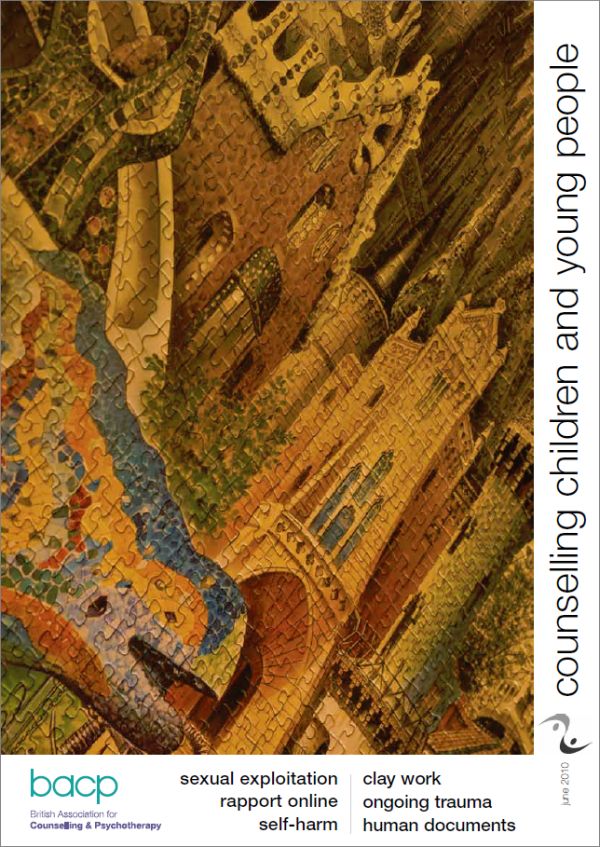In this issue
Awaken and engage
Peter Jenkins draws our attention to the grooming of children for sexual exploitation by gangs
Ongoing trauma
Even when a young person is not yet in a safe place, it is still possible to achieve good outcomes. Alastair Black explains
Clay days
Clay has distinctive attributes and deserves a place in every counselling room, says Eleanor Patrick; and three practitioners share case studies
Rapport in cyberspace
Jethro Adlington describes how we can ensure good connections with online clients
SupervisionTalk 2
Julie Fallon continues her series. This time: working with experienced or accredited counsellors
No longer taboo
Groupwork with clients who self-harm. Tracey Brooks and Abby Silva report from Streetwise in Newcastle
Can’t go, won’t go!
Val Taylor notes some strategies to engage clients who skip school
The duty to refer
Dennis Lines has thoughts – and doubts – about our ‘reporting culture’
Living human documents
Children need to be read and understood, says Jenny Bloomer
Research
School-based emotional health interventions – how do we know they work? Report from The Place2Be’s first research conference
From the chair

Not all articles from this issue are available online. Divisional members and subscribers can download the pdf from the BACP Children, Young People and Families archive.
Welcome from the editor
Virginia Woolf said: ‘A woman must have money and a room of her own if she is to write fiction.’1 Alter that to ‘time and a room of one’s own’ and you appear to have the perfect requirement for the child counsellor or psychotherapist, male or female.
Well, maybe not quite. These days, a simplistic recipe is often insufficient. Schools demand a more pervasive intervention from the counsellor, as Julie Fallon discusses in SupervisionTalk. The child’s external trauma triggers should be gone but they may not be, and we need to be able to work with the family system too, as Alastair Black points out from his work in Northern Ireland. And counselling has to reach young people as they flit between XBox, computer and mobile with an iPod plugged onto their heads (so do read Jethro Addlington’s contribution on how to build rapport with them online). Considering all this, ‘time and a room of one’s own’ does indeed begin to sound like fiction – so last century. We need much more nowadays. And new skill sets and understandings figure among the prerequisites.
One basic necessity is an understanding of the development of children and young people and their many circumstantial variations that demand a close reading and contemplation of their unique lives (see ‘Living human documents’). And among the ‘shoulds’ these days, there jumps up that dreaded imperative to disclose immediately or risk the law courts (see Dennis Lines’ appeal for your views). Besides, if we stay in that ‘room of one’s own’, how would we reach those young people being groomed to provide sex to adult gangs in large cities (see Peter Jenkins’ lead article on this most disturbing of subjects)?
Of course, money does come into the equation somewhere, as Woolf points out. The current funding for all kinds of interventions (for instance, the Targeted Mental Health in Schools (TAMHS) programme) is not necessarily going to be continued. And sufficient provision is indeed the bottom line for child therapists, if we are to continue to deliver help to a needy population. In the aftermath of an election, when every last kind of ‘faction’ has been told in order to gain the voter’s crucial commitment, we may have to become political animals as well, and make our voices heard by the new Government on behalf of those who suffer. Otherwise, the work may not continue at all – in or out of our cosy little rooms.
But while it does, I commend to you our latest book offer for your summer reading and also the Chair’s invitation to apply for one of the vacancies on the Executive Committee, if you feel your talents lie in that direction.
Eleanor Patrick
Editor
Reference
1 Woolf V. A room of one’s own. London: Penguin Books; 1945.
